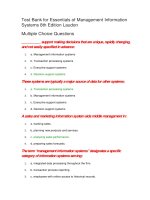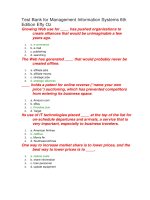Enterprise manage information systems 6th by laudon ch03
Bạn đang xem bản rút gọn của tài liệu. Xem và tải ngay bản đầy đủ của tài liệu tại đây (705.96 KB, 57 trang )
Chapter 3
Essentials of Management Information Systems, 6e
Chapter 3 Information Systems, Organizations, Management, and Strategy
Information Systems, Organizations,
Management, and Strategy
3.1
© 2005 by Prentice Hall
Essentials of Management Information Systems, 6e
Chapter 3 Information Systems, Organizations, Management, and Strategy
Objectives
1. What do managers need to know about
organizations in order to build and use
information systems successfully?
2. What impact do information systems have on
organizations?
3. How do information systems support the
activities of managers in organizations?
3.2
© 2005 by Prentice Hall
Essentials of Management Information Systems, 6e
Chapter 3 Information Systems, Organizations, Management, and Strategy
Objectives
4. How can businesses use information systems for
competitive advantage?
5. Why is it so difficult to build successful
information systems, including systems that
promote competitive advantage?
3.3
© 2005 by Prentice Hall
Essentials of Management Information Systems, 6e
Chapter 3 Information Systems, Organizations, Management, and Strategy
Management Challenges
1.
Sustainability of competitive advantages
2.
Fitting technology to the organization
(or vice versa).
3.4
© 2005 by Prentice Hall
Essentials of Management Information Systems, 6e
Chapter 3 Information Systems, Organizations, Management, and Strategy
Organizations and Information Systems
The two-way relationship between organizations and information technology
Figure 3-1
3.5
© 2005 by Prentice Hall
Essentials of Management Information Systems, 6e
Chapter 3 Information Systems, Organizations, Management, and Strategy
Organizations and Information Systems
What Is an Organization?
Technical Definition
• Stable, formal social structure that takes resources
from the environment and processes them to
produce outputs
Behavioral Definition
• A collection of rights, privileges, obligations, and
responsibilities that are delicately balanced over a
period of time through conflict and conflict
resolution
3.6
© 2005 by Prentice Hall
Essentials of Management Information Systems, 6e
Chapter 3 Information Systems, Organizations, Management, and Strategy
Organizations and Information Systems
The technical microeconomic definition of the organization
Figure 3-2
3.7
© 2005 by Prentice Hall
Essentials of Management Information Systems, 6e
Chapter 3 Information Systems, Organizations, Management, and Strategy
Organizations and Information Systems
The behavioral view of organizations
Figure 3-3
3.8
© 2005 by Prentice Hall
Essentials of Management Information Systems, 6e
Chapter 3 Information Systems, Organizations, Management, and Strategy
Organizations and Information Systems
Common Features of Organizations
Structural Characteristics of All Organizations
•
•
•
•
•
•
3.9
Clear division of labor
Hierarchy
Explicit rules and procedures
Impartial judgments
Technical qualifications for positions
Maximum organizational efficiency
© 2005 by Prentice Hall
Essentials of Management Information Systems, 6e
Chapter 3 Information Systems, Organizations, Management, and Strategy
Organizations and Information Systems
Common Features of Organizations
Additional Features of Organizations
• Standard Operating Procedures (SOPs): Precise
procedures to cope with all expected situations
• Organizational Politics: Struggle to resolve divergent
viewpoints within the organization
• Organizational Culture: Fundamental assumptions
about what products the organization should produce
3.10
© 2005 by Prentice Hall
Essentials of Management Information Systems, 6e
Chapter 3 Information Systems, Organizations, Management, and Strategy
Organizations and Information Systems
Unique Features of Organizations
Organizational Types
• Entrepreneurial: Start up business
• Machine bureaucracy: Midsize manufacturing
firm
• Divisionalized bureaucracy: Fortune 500 firms
• Professional bureaucracy: Law firms, hospitals,
school systems
• Adhocracy: Consulting firm
3.11
© 2005 by Prentice Hall
Essentials of Management Information Systems, 6e
Chapter 3 Information Systems, Organizations, Management, and Strategy
Organizations and Information Systems
Environments and organizations have a reciprocal relationship
Figure 3-4
3.12
© 2005 by Prentice Hall
Essentials of Management Information Systems, 6e
Chapter 3 Information Systems, Organizations, Management, and Strategy
Organizations and Information Systems
Unique Features of Organizations
All organizations have different:
Organizational type
Environments
Goals
Power
Constituencies
3.13
Function
Leadership
Tasks
Technology
Business processes
© 2005 by Prentice Hall
Essentials of Management Information Systems, 6e
Chapter 3 Information Systems, Organizations, Management, and Strategy
Organizations and Information Systems
Window on Organizations
E-Commerce French and German Style
What organizational factors explain why France
and Germany have had such different experiences
adopting e-commerce?
3.14
© 2005 by Prentice Hall
Essentials of Management Information Systems, 6e
Chapter 3 Information Systems, Organizations, Management, and Strategy
The Changing Role of Information Systems in Organizations
Information Technology Infrastructure and Information Technology Services
Information Services Department
Past: Consisted primarily of programmers, building
own software and managing own computing
facilities
Today: A growing proportion of specialists, with
department acting as powerful change agent in the
organization
3.15
© 2005 by Prentice Hall
Essentials of Management Information Systems, 6e
Chapter 3 Information Systems, Organizations, Management, and Strategy
The Changing Role of Information Systems in Organizations
Information technology services
Figure 3-5
3.16
© 2005 by Prentice Hall
Essentials of Management Information Systems, 6e
Chapter 3 Information Systems, Organizations, Management, and Strategy
The Changing Role of Information Systems in Organizations
How Information Systems Affect Organizations
Economic Theories
• Information system technology is a factor of
production, freely substituted for capital and labor
• Transaction cost theory: Information technology
can help lower the cost of market participation
3.17
© 2005 by Prentice Hall
Essentials of Management Information Systems, 6e
Chapter 3 Information Systems, Organizations, Management, and Strategy
The Changing Role of Information Systems in Organizations
The transaction cost theory of the impact of
information technology on the organization
Figure 3-6
3.18
© 2005 by Prentice Hall
Essentials of Management Information Systems, 6e
Chapter 3 Information Systems, Organizations, Management, and Strategy
The Changing Role of Information Systems in Organizations
How Information Systems Affect Organizations
Economic Theories – The Agency Theory
• Agents (employees) need supervision
• As firm grows, agency and coordination costs rise
• Information technology reduces agency costs
because it becomes easier for managers to oversee
more employees
3.19
© 2005 by Prentice Hall
Essentials of Management Information Systems, 6e
Chapter 3 Information Systems, Organizations, Management, and Strategy
The Changing Role of Information Systems in Organizations
The agency cost theory of the impact of
information technology on the organization
Figure 3-7
3.20
© 2005 by Prentice Hall
Essentials of Management Information Systems, 6e
Chapter 3 Information Systems, Organizations, Management, and Strategy
The Changing Role of Information Systems in Organizations
How Information Systems Affect Organizations
Behavioral Theories
• IT could change hierarchy of decision making by
lowering costs of information acquisition and
distribution
• Organization shape could “flatten” as decision making
becomes more decentralized
• Growth of “virtual organizations”
• Information systems seen as outcome of political
competition between subgroups
3.21
© 2005 by Prentice Hall
Essentials of Management Information Systems, 6e
Chapter 3 Information Systems, Organizations, Management, and Strategy
The Changing Role of Information Systems in Organizations
Organizational resistance and the mutually adjusting relationship
between technology and the organization
Figure 3-8
3.22
© 2005 by Prentice Hall
Essentials of Management Information Systems, 6e
Chapter 3 Information Systems, Organizations, Management, and Strategy
The Changing Role of Information Systems in Organizations
The Internet and Organizations
• The Internet is capable of dramatically reducing
transaction and agency costs
• Businesses are rapidly rebuilding some key business
processes based on Internet technology
• Internet technology becoming a key component of IT
infrastructure
3.23
© 2005 by Prentice Hall
Essentials of Management Information Systems, 6e
Chapter 3 Information Systems, Organizations, Management, and Strategy
Managers, Decision Making, and Information Systems
The Role of Managers in Organizations
Classical Model:
•
•
•
•
•
3.24
Five Functions of Managers
Planning
Organizing
Coordinating
Deciding
Controlling
© 2005 by Prentice Hall
Essentials of Management Information Systems, 6e
Chapter 3 Information Systems, Organizations, Management, and Strategy
Managers, Decision Making, and Information Systems
The Role of Managers in Organizations
Behavioral Models:
•
•
•
•
•
3.25
Five Attributes of Managers
Perform much work at non-stop pace
Fragmented activities
Prefer speculation, hearsay, current and ad-hoc
information
Prefer oral communication
Maintain diverse web of contacts as informal
information system.
© 2005 by Prentice Hall









